Water is a vital resource for sustaining life, and its availability is crucial for the well-being and development of any society. In China, a country with a rich cultural heritage and a large population, water management has always been a matter of utmost importance. One of the key elements of China’s water infrastructure is the water well, which has played a significant role in the country’s history and continues to be relevant in modern times. In this article, we will explore what a water well is in China, its historical significance, and its relevance in contemporary China.
what is a water well?
A water well is a man-made structure or excavation designed to access groundwater sources below the Earth’s surface. It is typically a vertical hole or shaft that is drilled, dug, or constructed using various methods and equipment. The purpose of a water well is to reach an underground aquifer or water-bearing rock layer and extract water for various uses.
The construction of a water well involves drilling or digging through the soil and rock layers until the water table is reached. The water table refers to the level below which the ground is saturated with water. Once the water table is reached, the well is equipped with a casing, which is a pipe that prevents the well from collapsing and ensures that the water is extracted from the desired depth.
The extraction of water from a well can be done using a pump or through natural flow if the water pressure is sufficient. Pumps are commonly used to draw water from the well and deliver it to the surface for drinking, irrigation, industrial processes, or other purposes.
Water wells vary in size and depth depending on factors such as the location, geology, and intended use. Some wells are shallow, reaching a few meters into the ground, while others can be several hundred meters deep. The depth of the well is determined by the depth of the water table and the specific water requirements of the area.
In addition to being a source of water, wells can also be equipped with monitoring systems to measure water levels, quality, and other parameters. This information helps in managing and conserving water resources effectively.
Water wells are vital in areas where access to surface water, such as lakes or rivers, is limited or unreliable. They provide a reliable and independent source of water, particularly in rural and remote regions where infrastructure for centralized water supply systems may be lacking.
Overall, water wells are essential for accessing groundwater resources and ensuring a sustainable water supply for communities, agriculture, and various industries.
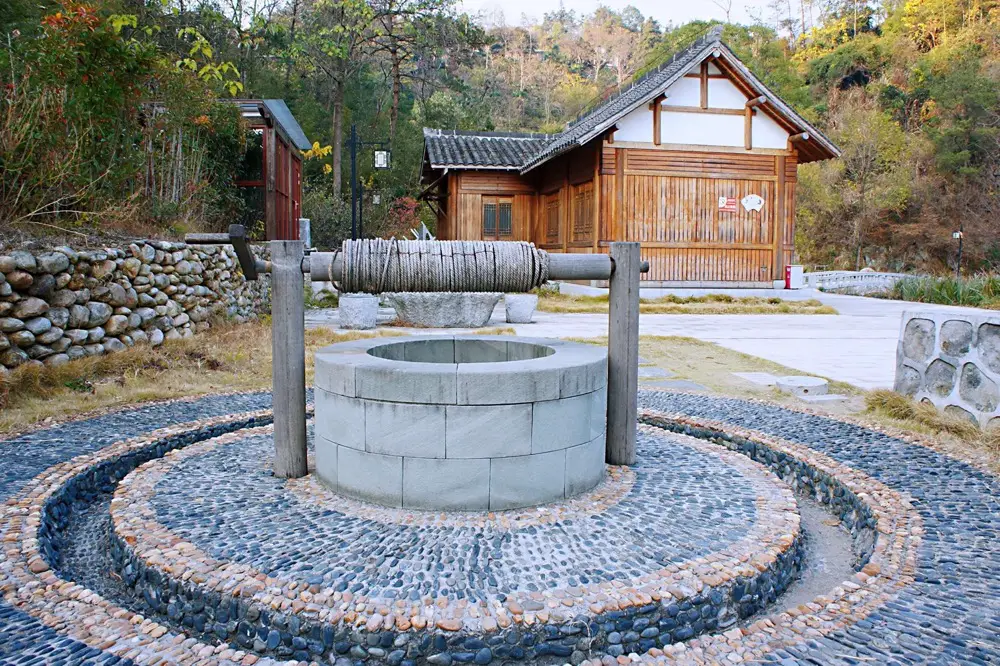
types of water wells
Based on the distribution of underground water and the geological structure of aquifers, various types of wells have been created. The traditional type widely used in China is the circular shaft well. It typically has a diameter of 1 to 2 meters and a depth ranging from a few meters to 20 to 30 meters. During construction, people can directly descend into the well shaft to excavate soil and rocks. This type of well is suitable for extracting shallow groundwater. To extract deep groundwater, smaller-diameter (from a few centimeters to several tens of centimeters) but considerably deeper (from tens of meters to several hundred meters) tube wells have been developed. Constructing tube wells requires specialized drilling machinery and more complex processes. As early as 250 BC, in what is now Sichuan Province, China, deep wells reaching tens to hundreds of meters were excavated in hard rocks for the extraction of brine used in salt production. After drilling, when pressurized aquifers containing brine were exposed, groundwater often flowed out of the well on its own. These wells are known as artesian wells. The place name Ziliujing in Zigong City, Sichuan Province, China, is derived from the artesian wells there. In modern times, countries around the world mainly use tube wells to extract groundwater, employing power drilling machines and various types of water pumps for lifting water. Before 1949, only a few cities in China had a small number of tube wells, and there were even fewer wells using power for lifting water. By 1980, the number of power-lifting wells in the country had reached 2.2 million, widely used for urban water supply, agricultural irrigation, and other purposes.
- To adapt to different geological conditions, inclined wells and horizontal wells have been developed. To increase the yield of wells, radial wells were later introduced, which combine horizontal filter pipes with vertical well shafts. The main well shaft of this type of well can have a diameter of several meters, while the length of the horizontal filter pipe ranges from tens to over a hundred meters. It is suitable for extracting shallow and thin, loose, or partially cemented aquifers. It can also be used to intercept sub-flows beneath riverbanks and riverbeds. Radial wells in gravel layers can have a maximum yield of 1 cubic meter per second. Radial wells drilled in loess in northwest China often have a yield ten to several tens of times higher than that of an equivalent-diameter shaft well.
- The water source structure of groundwater wells is generally divided into shallow groundwater and confined groundwater. Shallow groundwater is located in the first aquifer above the first confining layer in the geological structure. It is formed by infiltration of atmospheric precipitation and surface runoff, and is relatively shallow, rapidly replenished, with poor water quality, and both water quantity and quality are influenced by precipitation and runoff. A typical example is well water (non-artesian wells). Confined groundwater is the water filling the aquifer between two confining layers. It has two different types of burial: confined aquifers above the first stable confining layer and confined aquifers between two stable confining layers.
- Shallow wells primarily rely on shallow groundwater as their water source. These are commonly used by farmers and typically have water sources within a depth of 20 meters. The water quality of shallow wells is relatively susceptible to contamination.
- Deep wells primarily rely on confined groundwater. They require the use of drilling equipment to extract water from depths below 20 meters. The water sourced from deep wells is characterized by stable water quality and is generally better than shallow groundwater.
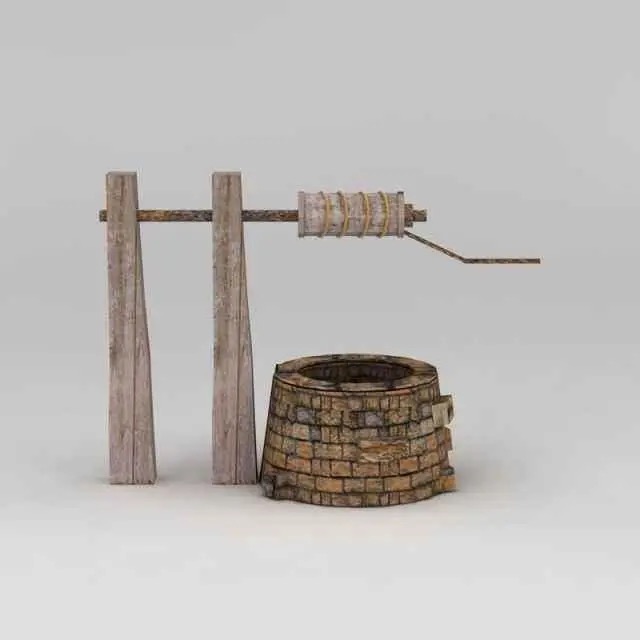
Karez(Turpan water system)
Karez wells are an underground water engineering system created by the laboring people in arid regions during a long historical development. Karez wells extract groundwater and transform deserts into oases. In ancient times, they were referred to as “wells and canals.” The main principle of a Karez well is to harness the large amount of rainwater, glacier meltwater, and snowmelt that infiltrates the ground during spring and summer seasons. This water is then diverted to the surface for irrigation in desert areas, fulfilling the water needs for production and daily life. Karez wells have specific regional characteristics in their construction, varying in structure across different areas. However, generally speaking, a complete Karez system consists of four main components: vertical wells, underground channels (subterranean conduits), surface channels (above-ground conduits), and small reservoirs known as “cogan.” Operating on this principle, Karez wells maintain a stable flow rate and ensure self-flow irrigation of the well water.
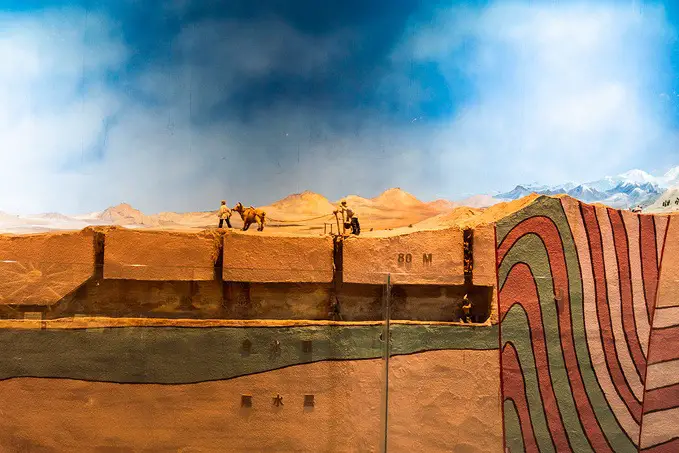
what is a water well used for in China?
Water Drawing
In the past, this water well at the village entrance used to be a great help for everyone. Back then, every household raised animals such as pigs, sheep, and chickens. If a family’s livestock lacked water, they would fetch water from the village well. Water from the well was also used for washing clothes. Next to the well, there was a 5.6-meter-long cement trough, and the elder women in the village would bring their dirty laundry to wash in the moss-covered trough, drawing water from the nearby well. They would chat and catch up while washing clothes. Looking back, that scene feels so warm and familiar. At that time, there were no convenient methods for water retrieval. People used a metal or plastic bucket tied to a coarse hemp rope, which they lowered into the well and then pulled up to retrieve water.
Fish Farming
Besides providing daily water needs, the well also had an unexpected function—fish farming or turtle keeping. You wouldn’t believe how well fish thrived in the water from the well. With clear and clean water, one could raise a few bright goldfish or dark crucian carp. The water grass in the well served as their food, and watching the small fish swimming around brought the water to life.
Food Cooling
During the summer, the well became our natural refrigerator. In those days, we didn’t have refrigerators at home. How could we enjoy chilled watermelon during the summer? We would take a bamboo basket, put the watermelon inside, and hang it in the well, or fill a bucket with well water, immerse the watermelon inside, and let it chill for a few hours. Then we would take it out, cut it open, and enjoy the refreshing taste. If we wanted to have chilled beer or cold noodles, we would simply place them in a basin and submerge them in the well water. The result was an incredibly refreshing experience, but now we can only reminisce about that particular flavor.
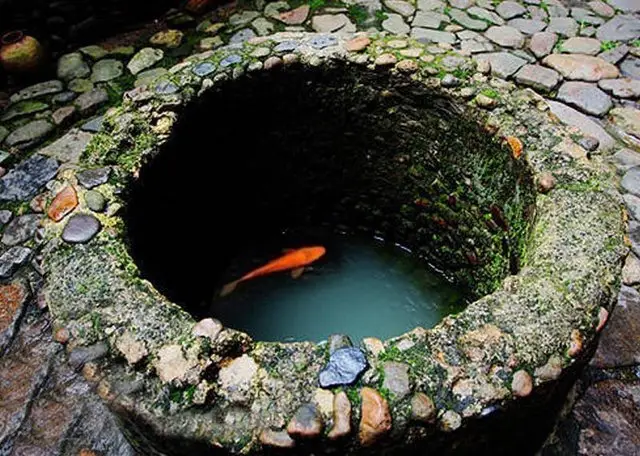
how does a water well work?
A water well is a structure that is drilled, dug, or constructed to access groundwater, which is the water present beneath the Earth’s surface in the saturated zone. The working principle of a water well involves tapping into underground aquifers or water-bearing rock formations to extract water for various purposes such as drinking, irrigation, or industrial use. Here’s how a typical water well works:
Drilling or excavation: The first step in creating a water well is to drill or excavate a hole into the ground until it reaches the desired depth where groundwater is expected to be present. The depth of the well depends on the local geology and the water requirements of the intended use.
Casing installation: Once the hole is drilled, a casing made of materials such as steel, PVC, or concrete is inserted into the well to prevent the sides from collapsing and to protect the water quality. The casing is typically perforated at the bottom section to allow water to enter the well.
Gravel packing: To enhance the flow of water into the well, a layer of gravel or sand is often placed around the casing. This helps filter out sediment and prevents the well from getting clogged.
Water table interaction: When the well is completed, it reaches a depth where it intersects the water table, which is the upper surface of the saturated zone. Water from the surrounding aquifer naturally flows into the well due to the pressure difference between the aquifer and the well.
Pumping mechanism: To extract water from the well, a pumping mechanism is employed. This can be a hand-operated pump, a submersible electric pump, or a windmill-powered pump, depending on the depth and purpose of the well. The pump creates a pressure differential that draws water from the well into a storage tank or directly into a distribution system.
Water storage and distribution: The water extracted from the well is typically stored in a reservoir or a storage tank, where it can be treated for purification if necessary. From there, the water can be distributed through a network of pipes for various uses, such as supplying households, irrigating fields, or serving industrial processes.
It’s important to note that the specific design and construction of water wells may vary depending on factors such as geological conditions, water table depth, local regulations, and the intended use of the water. Professional well drillers and hydrogeologists are typically involved in assessing the site, determining the appropriate well design, and ensuring the well’s efficient operation and longevity.
Why do the Chinese put turtles and fish in wells?
There are several possible reasons why Chinese people put turtles and fish in water wells:
Daily needs: In some areas, especially rural regions, water wells may serve as the primary source of daily water supply. To facilitate water access and enhance the functionality of the wells, people may introduce fish into the water. These fish can help clean the well by consuming weeds and insects, thus maintaining clear water quality. Additionally, if the well is used for irrigation purposes, having fish in the water can assist in controlling mosquitoes and pests, maintaining the ecological balance of the farmland.
Ecological balance: Water wells form relatively closed ecosystems, and by introducing turtles and fish, a small-scale ecosystem can be created. Turtles and fish can interact with each other, forming a simple food chain. This helps maintain the ecological balance within the well, preventing overpopulation of certain organisms while providing habitat for turtles and fish.
Entertainment and aesthetics: Placing turtles and fish in water wells can also provide entertainment and aesthetics. Turtles and fish in the well can serve as objects of leisurely observation, adding joy to people’s lives.
Belief in Deities
For ancient people, with their limited knowledge and understanding of nature, they created various deities to explain phenomena they couldn’t comprehend. In order to seek peace and protection, people would commemorate these revered deities in various ways, including placing turtles in water wells.
According to legend, there was a celestial being named Gun who was deeply troubled by the frequent occurrence of floods in the mortal world. To protect the people, Gun decided to ask the Heavenly Emperor for the magic soil to control the floods. However, the Heavenly Emperor refused Gun’s request. In desperation, Gun sought the help of a divine turtle and together they stole the magic soil, successfully eliminating the floods for the people.
However, the Heavenly Emperor later reclaimed the magic soil, plunging the mortal world back into devastating floods and ultimately killing Gun. But even after Gun’s death, his spirit did not dissipate; instead, it transformed into Great Yu, who continued the important task of flood control. The story of Great Yu’s efforts in flood control is well-known and needs no further elaboration.
Therefore, in later times, whenever people dug wells, they would place turtles in the water as a way to commemorate the celestial being Gun, hoping to receive his protection and ensure a prosperous and peaceful life.
Apart from commemorating Gun, there is another legend associated with worshiping another mythical creature called Xuanwu. It is said that after Gun was killed by the Heavenly Emperor, he transformed into Xuanwu, and this is one version of Xuanwu’s origin. However, regardless of the origin, Xuanwu has always been regarded as a legendary creature in our folklore, although it doesn’t exist in reality. Therefore, people use turtles as a substitute.
The main reason for placing turtles in water wells is the resemblance between turtles and Xuanwu. Being the deity of water, it is believed that placing turtles in wells ensures that the water will never dry up. Moreover, the water level in the well is closely related to the amount of rainfall.
For ancient people, agriculture was their fundamental means of survival, and abundant rainfall meant higher crop yields. Additionally, turtles have a long lifespan and, when placed in water wells, they are unlikely to die easily and pollute the water. This is another reason why ancient people liked to place turtles in their water wells.
It is important to note that before introducing turtles and fish into water wells, it is necessary to ensure that the water quality is suitable for their survival and that they will not have adverse effects on the local ecosystem. Proper management and maintenance are key to ensuring the ecological balance of the water well, and relevant laws, regulations, and protective measures should be followed.
Scientific Principles Involved
Apart from the worship of deities, the ancient practice of placing turtles in water wells also had some other reasons, which were very practical and included scientific principles.
Water quality testing: For ancient people, ensuring water quality was difficult, and laws were not as strict as they are now in terms of respecting life. In case of conflicts and grudges, there was a threat of poisoning the water well. However, the presence of turtles could effectively prevent such situations. If turtles were found dead for unknown reasons, it would raise the family’s alertness and indicate potential issues with the water quality, prompting them to be cautious and ensure the safety of their family members.
Furthermore, it was not only about preventing intentional poisoning but also about identifying unexpected occurrences that could affect the water quality. In ancient times, there were no advanced detection instruments available. Using turtles for testing was undoubtedly the most economical method.
Some experts also suggest that placing turtles in water wells allowed people to have timely information about natural disasters, facilitating them in taking necessary protective measures. As we know, human earthquake predictions are not very accurate, but animals seem to have an ability to sense impending disasters through their unusual behavior.
Therefore, if turtles inside the water well exhibit unusual agitation or behaviors, people can infer that significant natural disasters may occur in the near future. This knowledge enables them to take timely measures to mitigate the impact and reduce losses. Placing turtles in wells for prediction allows for more direct and convenient observation.
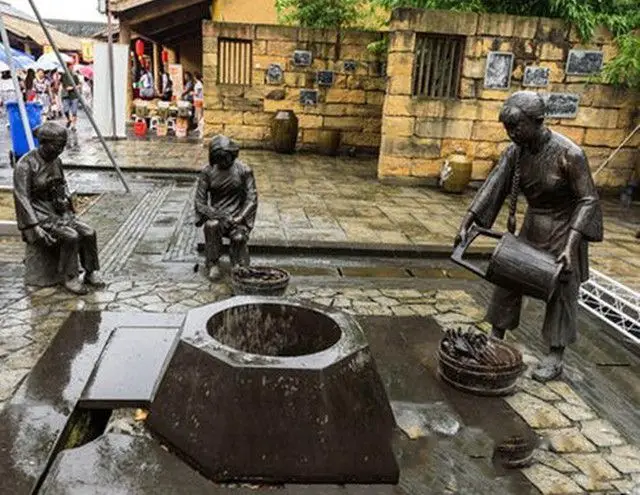
water well history
“Water wells” are an indispensable source of ancient Chinese hydroculture. Water is known as the source of life. In the early stages of primitive society, people would directly drink water from rivers, lakes, and streams. The introduction of “water wells” transformed people from passive to active water consumption. The concept of wells not only reflects the wisdom of ancient people but also marks a significant change in the history of human water consumption. References to wells can be found in various historical records, such as oracle bone inscriptions from the Shang Dynasty.
During the prehistoric period, the Hai-Dai region’s culture was limited to the period before the Hai-Dai Longshan culture. In contrast, in other regions, the Central Plains Liangzhu culture and Longshan culture, which were roughly the same age, emerged. The development of water wells during the prehistoric period went through a process from production to maturity, involving the timing and reasons for the appearance of water wells, as well as the similarities and differences in their patterns and forms. It represents an important stage in the history of well development. Scholars have conducted research starting from the origin and forms of water wells and have drawn useful conclusions, continuously deepening our understanding of water wells.
Before the advent of water wells, people relied on areas with underground water or springs for their survival. The invention of deep water wells expanded the range of human activities. China is one of the pioneering countries in the comprehensive utilization of surface water. One deep water well discovered in China is located at the Hemudu archaeological site in Yuyao, Zhejiang province, dating back approximately 5,700 years. This well was a highly sophisticated square wooden structure with a depth of 1.35 meters and a circumference of 2 meters. It can be inferred that the initial form of wells appeared much earlier.
It was not until the 1950s that we imported impact rotary drilling rigs from abroad. Simple water well drilling rigs, such as casing hammers and percussion grab cones, were produced in the early 1960s. Positive circulation rotary drilling rigs were initially developed around 1966, while reverse circulation rotary drilling rigs and compound drilling rigs were successfully developed around 1974. Down-the-hole hammer vibration rotary drilling rigs were created in the late 1970s. In the 19th century, countries like Europe and the United States primarily used wire rope impact drills. In the 1960s, France mainly used rotary drilling rigs, which were introduced to the United States and rapidly developed.
As people’s quality of life improves, there is a growing demand to enhance our living standards. Among many requirements, water is essential to our daily lives, and water safety is of paramount importance. To achieve a better quality of life, many places are gradually adopting deep wells. These wells, with depths ranging from 20 to 300 meters, provide water that has been thoroughly filtered and are relatively safe.
Archaeological excavations have revealed more than ten ancient well sites in the Guanzhong area of China.
Zhou Dynasty Wells: Eight shallow earthen wells were discovered in the Fenghao archaeological site, located north of Doumen Street in Chang’an District, Xi’an. These wells, each over 9 meters deep, had rectangular or oval-shaped shafts. They were primarily used for domestic water supply and possibly for irrigation purposes. A similar oval-shaped well was found in Renjia Village near Famen Temple in Fufeng County. Additionally, one early Western Zhou period well with stone masonry walls was discovered, differing significantly from the earthen wells. The well walls were constructed entirely using stone blocks, providing excellent water permeability and durability.
Warring States Wells: In Keshengzhuang, Chang’an District, 26 rectangular wells measuring approximately 1.6 to 2 meters by 1 meter were found. In Liyang, Lintong District, four circular pottery pipe wells with a diameter of 0.9 meters were discovered. These wells had depths exceeding 10 meters.
Qin Dynasty Wells: Four pottery pipe wells were found in the Luyang Palace, the capital of the Qin Dynasty (now located north of the Wei River within Yanliang District). Each well had a ring diameter of 0.9 meters, a height of 0.3 meters, and a wall thickness of 3 centimeters. The outer walls of the rings displayed rope patterns. Each well was constructed using 10 to 20 sections of pottery rings and served as a water source for the palace.
Han Dynasty Wells: Two oval-shaped brick wells were unearthed in Douma Village, Xingping County. The upper opening had a diameter of 0.8 meters, while the bottom measured 1.5 meters. The entire well structure was built using interlocking cloud-patterned bricks. Additionally, there were pottery water conduits located near the well.
Tang Dynasty Wells: In the original site of Jiucheng Palace in Linyou County, one brick-constructed Tang Dynasty well was discovered. The well shaft was circular with a diameter of 0.9 meters and a depth of 10 meters. There was a 16-square-meter large stone well platform surrounding the well, built with square bluestone slabs. The well opening was enclosed with chiseled bluestones in a petal-like pattern. The well shaft was entirely constructed using blue bricks, gradually tapering inwards from bottom to top in a trapezoidal shape. To the north of Emperor Taizong Li Shimin’s mausoleum in Liquan County, remnants of a stone well cluster, known as Baiyan Stone Wells, were preserved. These wells were primarily used for tomb construction, expanding the mausoleum area, horse breeding, and potentially for irrigation. With a diameter of 0.7 meters, these vertical wells reached a depth of around 90 meters, extracting water from fractures in bedrock. Nine stone wells are still well-preserved to this day.
when was the water well invented?
The exact origins of water wells are difficult to determine, as they were likely developed independently in different regions of the world. However, the concept of digging or constructing a deep hole to access groundwater is ancient and dates back thousands of years.
Evidence suggests that the earliest known water wells were developed in several regions around the world during the Neolithic period (around 10,000 to 4,500 BCE). For example, archaeological excavations have uncovered early well structures in locations such as Jericho in the West Bank (c. 8000 BCE), Cyprus (c. 7000 BCE), and India (c. 6000 BCE).
In China, the discovery of ancient water wells dates back several millennia. The earliest known well in China is believed to be the one found at the Hemudu archaeological site in Yuyao, Zhejiang Province, which dates to around 5700 BCE. This well had a square wooden structure and was approximately 1.35 meters deep with a side length of 2 meters.
It’s important to note that these dates are based on current archaeological findings and may be subject to revision as new discoveries are made. Additionally, different regions and civilizations may have independently developed their own methods of accessing groundwater, making it challenging to pinpoint a definitive date for the invention of water wells.
who invented the first water well?
In China, the discovery of ancient water wells dates back thousands of years. The well found at the Hemudu archaeological site in Yuyao, Zhejiang Province, is one of the earliest known examples. It dates to approximately 5700 BCE, during the Neolithic period.
The well at the Hemudu site is notable for its square wooden structure. It was about 1.35 meters deep and had a side length of 2 meters, as you mentioned. This early well demonstrates the ingenuity and practical knowledge of ancient Chinese civilizations in developing methods to access groundwater.
The discovery of such ancient wells provides valuable insights into the technological advancements and the significance of water management in early Chinese societies. It indicates their understanding of the importance of a stable water supply and their ability to construct structures to extract water from the ground
where does a water well come from?
The concept of a water well, as a source of accessing groundwater, has been developed independently in various regions around the world throughout history. The origin of water wells can be traced back to ancient civilizations that recognized the need for a reliable and accessible water supply.
The exact origin of the water well is difficult to determine, as it predates recorded history. However, it is believed that the practice of digging wells emerged in arid and semi-arid regions where surface water was scarce or unreliable. Early human settlements realized the importance of accessing groundwater for drinking, irrigation, and other purposes.
The construction of water wells typically involves digging or drilling a hole into the ground until reaching an aquifer or water-bearing layer. Various techniques and tools have been employed throughout history to create wells, including hand-digging, using primitive tools, or employing more advanced drilling methods as technology progressed.
Different cultures and civilizations developed their own methods and technologies for well construction based on their available resources and knowledge. Over time, advancements in engineering, such as the use of materials like wood, stone, or brick, as well as the introduction of mechanical devices and pumps, have contributed to the evolution of well construction techniques.
It is important to note that the development of water wells was not limited to a single culture or time period but emerged independently in different parts of the world as a fundamental solution for accessing groundwater and ensuring a sustainable water supply.
styles of Chinese water well
The earliest form of wells was the “tu jing” or earth well, which was shallow and prone to collapse, making it difficult to maintain hygiene. During the Shang Dynasty, people began using wooden wells, which involved installing wooden rings on the well walls and bottom. This practice prevented the collapse of the well walls to a certain extent and ensured cleaner water for human use.
The wooden wells can be considered as an enhanced version of the earth wells. During the Spring and Autumn Period and the Warring States Period, known for their bronze and pottery craftsmanship, an advanced type of well called the “tao quan jing” or pottery ring well was developed. It involved stacking pottery rings in the well, creating a cylindrical structure.
The advantage of this type of well was that the pottery rings were grooved at the upper and lower ends during the pottery-making process. This ensured tighter and better-fitting joints between the rings, preventing the infiltration of sediment into the well. Additionally, it improved the water quality within the well.
During the Han Dynasty, another type of well called the “zhuan jing” or brick well emerged with the introduction of bricks. With advancements in brick-making technology, various types of bricks were produced. By examining some well sites, it can be observed that brick wells had smoother and stronger walls, stricter water filtration processes, and cleaner water. After the Han Dynasty, brick wells became more commonly used by humans, although some special types of wells also existed.
Based on various sources, during the Neolithic period, earth wells were predominant with fewer instances of wooden wells. During the Xia, Shang, and Western Zhou Dynasties, earth wells were the main type. During the Spring and Autumn Period and the Warring States Period, earth wells and pottery wells were predominant, followed by tile wells, with wooden wells being rare and earth wells occupying a prominent position.
Ever-changing Styles of Water Wells
(I) Square Wells
Square wells were the earliest well structures in China, including rectangular and square wells. Square wells were commonly found in the pre-Qin period, the Neolithic period, and the Qingdong pottery period, but were less prevalent during the Iron Age.
During the Xia and Shang dynasties, rectangular and square wells were predominant, and most of the square wells discovered from the Spring and Autumn period to the Warring States period were located in the Yellow River basin. The reason why square wells became the initial form of wells and persisted for such a long time, in my opinion, is that humans had not yet grasped the characteristics of circles, and squares were considered advantageous for balancing forces and maintaining stable well frames. The transformation from square wells to circular wells was definitely not an overnight process.
A wooden deep well from the Neolithic period was discovered at the Baiying Village site in Tangyin, Henan Province. This is the earliest and structurally most complex well found in the Central Plains region of China to date. The well mouth is rounded rectangular in shape, with a larger opening at the top and a smaller opening at the bottom. The upper part of the well mouth is divided into two layers: the larger opening measures 5.8 meters in length from north to south and 6.6 meters in width from east to west, while the smaller opening extends 0.55 meters below and measures 3.8 meters in length from north to south and 3.6 meters in width from east to west. The well bottom is 1.20 meters long, 1.10 meters wide, and 11 meters deep. The upper section of the well wall inclines outward while the lower section is relatively straight.
The well wall is constructed by interlocking birch crossbeams in a zigzag pattern, layer by layer, from top to bottom. At the intersections of the wooden beams, the smaller beams fit into notches of the larger beams, resulting in a total of 46 layers to form a zigzag-shaped framework.
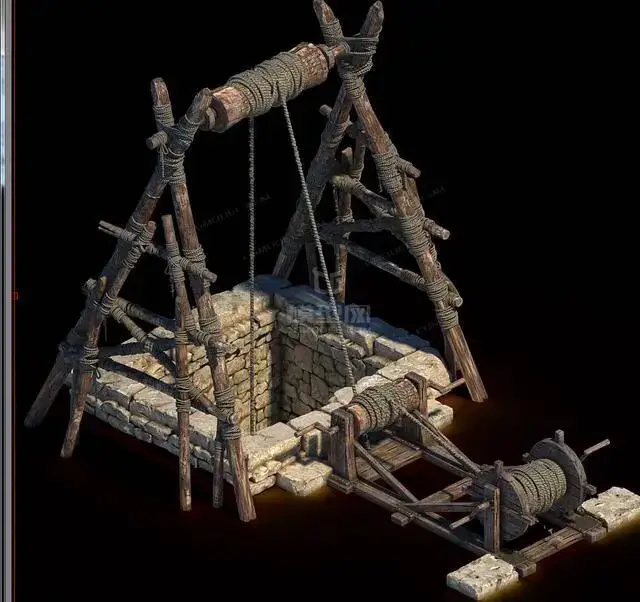
(II) Circular Wells
Circular wells are the main type of well structure in China, including elliptical and nearly circular wells. Circular wells emerged during the pre-Qin period. With the development of society, the number of circular wells also increased. Compared to square wells, circular wells have more advantages, are easier to promote, and have a greater vitality.
During the Song Dynasty, some wells were discovered along the moat of the city wall in Wuxi, Jiangsu Province. These wells were constructed using a single-brick horizontal and staggered-angled stacking method.
This construction method already existed in the late Tang Dynasty. In addition to the brick walls, bamboo strips were used to encircle the well, and small wooden wedges were inserted between the brick wall and the bamboo strips, with the thick ends of the wedges facing downward. This construction method was highly advanced, allowing the well to continue functioning even if there was sand movement or sinking of the well wall.
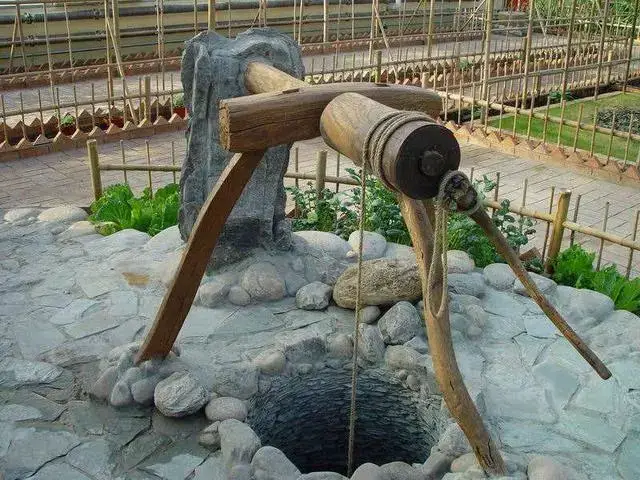
(III) Irregular Wells
Irregular-shaped well: It is not a singular square or circular well, but a combination of various shapes. For example, a late Shang Dynasty irregular-shaped well was discovered at the Shendun site in Jiujiang, Jiangxi.
The well has an upper circular section and a lower funnel shape. Its diameter is 3.30 meters from east to west, 3.50 meters from north to south, and it has a depth of 6.95 meters. From the well opening, it slopes downward to a depth of 2.40 meters, where the well wall becomes straight and the cross-section forms a rounded square with sides measuring 2.4 meters. At the bottom of the well, there is a square two-tiered platform with sides measuring 1.30 meters, a width of 0.20 meters, and a height of 0.60 meters. The interior of the platform is shaped like a pot bottom, with a depth of 0.5 meters.
In addition, there is a set of water filtration facilities on the three-tiered platform. Its structure involves layering wooden sticks crisscrossed on the platform railing, covering them with bamboo mats, and placing a stone slab on top. The entire well wall is smooth and even, without any traces of tooling, and there are no footprints. The well bottom contains a large number of wooden sticks, bamboo utensils, rattan strips, stones, and red clay. Two wooden barrels were also found. It can be inferred that this well was used for a manual workshop at that time.
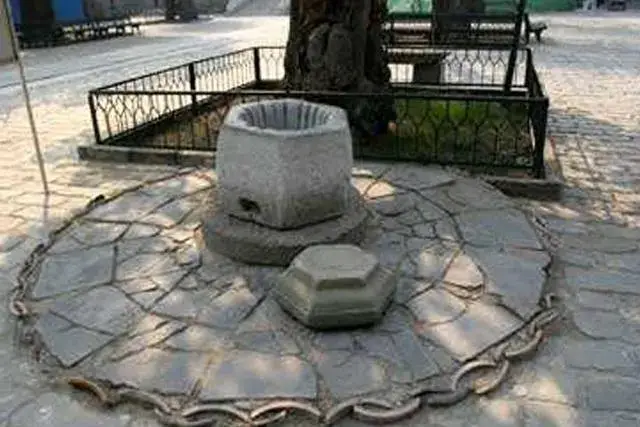
Complex and Variable Well Drilling Techniques
It is well known that due to different geological conditions and surface topography, the quantity of groundwater, the depth of the water table, and the quality of water vary. Wells are constructed to better utilize groundwater. However, based on existing records, it is impossible for people to determine the quantity of groundwater, the depth of the water table, and the water quality using ancient tools.
However, it would be a mistake to say that ancient people had no understanding of these factors. Xu Guangqi’s book “The Complete Book of Agricultural Administration” provides detailed discussions on selecting good water sources and drilling techniques.
This book elaborates on the selection of well locations and drilling techniques. From this book, we can learn that ancient people already had preliminary knowledge of groundwater. They selected well locations based on topography, terrain, and the exposure of groundwater. In addition, the book also documents commonly used folk methods such as gas testing, fire testing, and plate testing, which are both scientifically sound and easy to implement. Even today, some rural areas in China still use these methods to drill wells.
The Qing Dynasty’s compilation “Yuanjian Lei Han · Di Bu” also records methods for selecting well locations: “Yichong Qiu yi zao xi, lin chi ze zhi yin fen…” From this poem, we can see that people of that time could already select relatively suitable well locations based on terrain conditions. The phrase “lin chi yang zhi yin fen” means drilling a well in this location where the water table is higher, making it easier to obtain water. According to geological research, this method has a scientific basis and is practical.
The primary issue in well drilling for water supply is how to find the well location. It is evident that ancient people had accumulated a considerable amount of knowledge in this regard. Once the site selection problem was solved, how did they drill to a sufficient depth to reach water?
From the early water pits of the pre-Qin period to the later development of earth wells, wooden wells, pottery wells, tile wells, and brick wells, it can be seen that ancient wells in China underwent significant advancements in their structure. However, the most important aspect of a well is the wellbore. If the wellbore collapses, the well becomes useless.
The earth well was both the earliest form of a dug well and the foundation for the development of various types of wells. During the Neolithic period, humans had limited tools, so the wells they dug were more like individual water pits.
During the Xia, Shang, and Western Zhou periods, social progress led to further development in drilling techniques. The appearance and use of drilling tools were the most significant indications of progress. For example, digging tools included stone shovels and wooden spades, while soil transportation tools consisted of woven bamboo strips, willow strips, and wooden baskets.
In addition, new measuring instruments emerged, such as wooden plumb bobs and wooden markers, which helped make the dug wells more rounded and vertical. Furthermore, footprints were found on the wellbore of some earth wells, suggesting that they were mainly used in conjunction with tools such as wooden ladders, ropes, or soft ladders, making it easier for people to move up and down the well.
In addition to these tools, there were also pottery containers used to transport water that suddenly emerged or gradually seeped from the bottom of the well. With the problem of site selection and excavation solved, the construction of water wells could be completed.
Han Dynasty water well
From archaeological discoveries, it can be observed that during the Han Dynasty, water wells were not only widely distributed but also numerous and diverse in their forms. This indicates that by the Han Dynasty, water wells had become highly popular, and the craftsmanship and technology related to well construction had greatly advanced.
Structure and Uses of Han Dynasty Water Wells
During the Han Dynasty, water wells were not only essential in people’s daily production and life but also symbolized the posthumous honor and mourning for the deceased. Models and clear vessels representing water wells were made by people and buried in tombs as symbols of wealth. Images of water wells and scenes of people drawing water were depicted in portraits, stone sculptures, and murals found in Han Dynasty tombs. The Han people held a sense of awe towards the heavens, earth, nature, and all unknown phenomena. Water wells were also endowed with a mystical power, and various abnormal phenomena observed in wells were often associated with daily life, agricultural production, and even political situations, forming a mythical well culture.
Compared to previous periods, the drilling techniques of water wells in the Han Dynasty had undergone significant developments. In terms of both depth and design, water wells during this period far surpassed those of the Spring and Autumn period, Warring States period, and pre-Qin period. Han Dynasty water wells mainly consisted of underground structures and above-ground facilities. The underground structures varied depending on the materials used and included earth wells, pottery wells, brick and stone wells, wooden wells, as well as wells constructed using a combination of various materials. The above-ground facilities mainly included well platforms, well fences, well frames, as well as well pavilions and screens. These above-ground facilities served the purpose of protecting people’s safety while drawing water and preventing leaves, debris, and wastewater from seeping into the well and contaminating the water.
The primary purpose of water wells was to provide relatively clean and safe drinking water to people and to supply water for cooking, slaughtering, washing, and cleaning in daily life. In addition, water wells played a significant role in agricultural development during the Han Dynasty. Farming during this period heavily relied on favorable weather and geographical conditions, making the presence of water sources near arable land crucial. If there were no natural water streams for irrigation near the farmland, water wells became the primary water source for agricultural irrigation. This was particularly important in arid and rainfall-deficient regions, where groundwater resources needed to be fully utilized.
The Cultural Significance of Wells in the Han Dynasty
Traditionally, wells are seen as the source of life and bring hope and aspirations to people. This sentiment was particularly strong during the Han Dynasty in China. Wells held a special place in people’s hearts during this period and were considered one of the “Five Sacrifices of the Han Dynasty” alongside gates, doors, hearths, and thunder. People believed that wells had a divine connection, leading to various rituals and prayers being conducted at wells, such as rainmaking ceremonies or prayers to stop rainfall. Furthermore, people held a sense of reverence and even fear towards wells in the Han Dynasty. The deep and dark structure of wells seemed to conceal many unknowns, which instilled fear in people.
Rituals, Blessings, and Prayers at Wells
Wells played a significant role in people’s lives during the Han Dynasty, and they were deified as spirits that could bless households and ensure their safety. Consequently, various rituals, blessings, and sacrifices were often conducted at wells.
Fear Associated with Wells
While wells brought positive influences, they also evoked fear in people. Wells were closely associated with death, and there are numerous accounts in Han Dynasty literature of people committing suicide or disposing of corpses in wells. Wells were regarded as possessing a certain divinity in the minds of people during that time, but this divinity was more akin to a mysterious and dangerous presence.
Extraordinary Phenomena in Wells as Omens and Disasters
Wells were often perceived as mysterious due to their deep, dark, and seemingly bottomless structure. When people looked down into the well, they could only see a small water surface, which triggered their imagination. The calm and tranquil water surface made any anomaly or abnormality appear as a supernatural phenomenon, and people believed it to be a sign or hint from the heavens. These signs were thought to be connected to the safety and well-being of individuals, families, entire communities, imperial power, and even the fate of the entire world.
Water Well Remains and Excavated Artifacts from the Han Dynasty
There are abundant records in Han Dynasty literature regarding water wells, including descriptions of wells and numerous related stories and anecdotes. People also created various models, paintings, and carved artworks depicting water wells, and there were even handmade artifacts specifically used for burial purposes. Therefore, the study of water wells from the Han Dynasty is of significant value in understanding the worldview and beliefs about life and death held by the people of that time.
Archaeological excavations have uncovered two main types of Han Dynasty water well remains: well sites and related discoveries found within tombs.
The number of Han Dynasty well sites is large and widely distributed. The quantity of wells during the Han Dynasty far exceeded that of the pre-Qin period, and they were found throughout the territory of the Han Dynasty. Most of these well sites are relatively well-preserved, facilitating a deeper understanding and research into the secular aspects, human geography, and providing a solid foundation for interpreting the water well culture of the Han Dynasty. During the Han Dynasty, people’s living standards were not highly developed, so they relied heavily on water wells in their daily lives and in agricultural and industrial production. Water wells held significant importance in the lives of people during that time and were indispensable public facilities in their society. Wherever people gathered, there were water wells.
Furthermore, water well sites often yield a large number of artifacts such as bones, bamboo, pottery, and other relics. In well sites such as Changsha Dongpailou Han Dynasty Ancient Well and Chenzhou Donghan Ancient Well in Hunan Province, a large number of Han Dynasty bamboo slips have been unearthed. These artifacts contain a wealth of historical information, providing valuable materials for the study of Han Dynasty history.
Water wells from the Han Dynasty found in tombs primarily consist of exquisite model Mingqi, such as pottery wells, as well as paintings, stone carvings, and murals within burial chambers. Among these, model Mingqi like pottery wells serve as symbols of the tomb owner’s social status. With the continuous development of Han Dynasty’s civilization and technological level, the number of water wells increased significantly, and their structures and design styles became diverse. This includes the internal structure of the wells, as well as the well platforms, well railings, and even the various methods used for drawing water.
Chinese water well pump
Chinese water well pumps have a long history and have evolved over time to meet the needs of different eras. Traditional Chinese water well pumps typically consist of a series of wooden or bamboo components and leverage manual power to extract water from wells or other water sources. Here are a few examples of traditional Chinese water well pumps:
Luluo
The “Luluo” is a popular water-lifting device used in folk communities in northern China, based on the principle of a wheel axle. It has a long history, dating back to 3000 years ago when our ancestors designed well-structured Luluo systems. It was commonly used for drawing water from wells and there are even records of its use for lifting copper ore from vertical shafts.
The Luluo consists of components such as the Luluo head, support frame, well rope, and water bucket. Typically, a well frame is erected over the well, with a shaft mounted on top that can be operated by a handle. The rope is wound around the shaft, with one end attached to the water bucket. By rotating the handle, the bucket is raised and lowered, extracting water from the well. It is one of the most primitive lifting devices. The manufacturing and application of Luluo were closely linked to the development of agriculture in ancient times, and it was widely used in agricultural irrigation. The application of Luluo in China has a long history, and although it has undergone improvements over the years, its basic form has been preserved.
In recent years, in some mountainous areas of northern China where the groundwater is deep, Luluo is still used for drawing water for drinking and irrigating the land. However, with the advancement of mechanization, this water-lifting device, which has been used for thousands of years, is gradually fading from people’s sight and becoming a preserved memory of history.
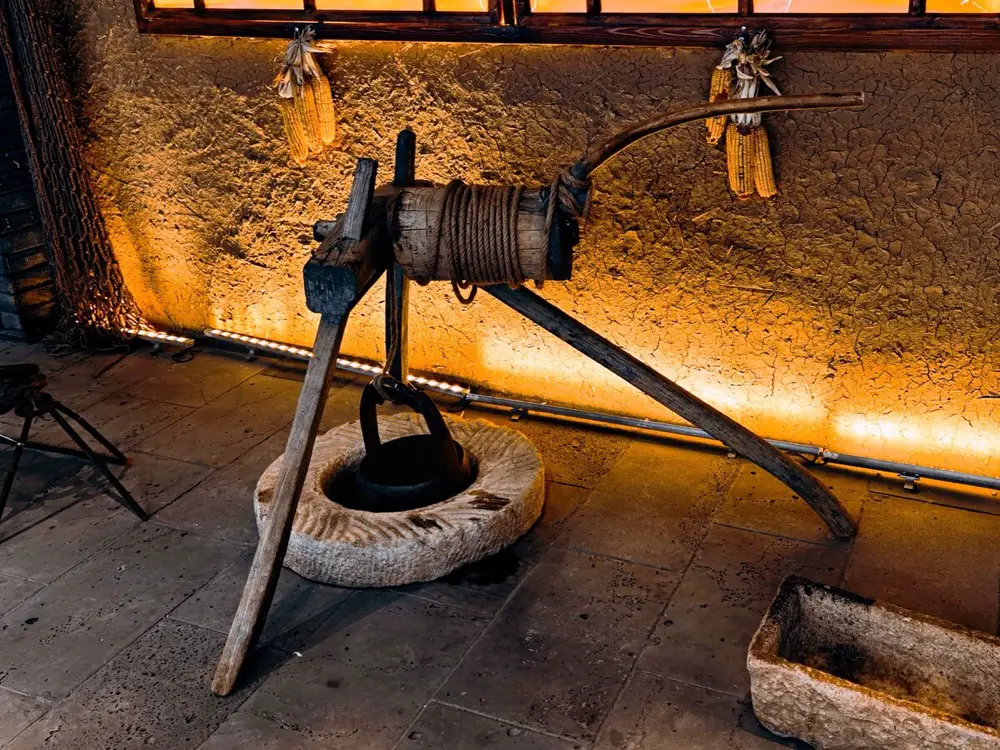
well cart
The well cart, also known as the bucket chain pump, is an ancient tool that originated from the development of the windlass and was used for lifting water from deep wells for irrigation purposes. It was primarily used during the Sui and Tang dynasties in China. The well cart was operated by animal or human power. Water-filled buckets were continuously lifted by the cart, bypassing a large wheel and pouring into a water sieve before flowing into the fields. Then, the empty buckets would descend, and the process would repeat.
In the northern regions of China, the well cart was mainly used for vertical underground water extraction. In the southwestern regions, it was primarily used for extracting brine from salt wells.
The well cart consists of multiple wooden buckets connected in a chain-like fashion using small horizontal axles. This chain of buckets is then placed on top of a large wheel positioned over the well. At one end of the wheel’s axis, a large spur gear is installed, which meshes with a corresponding large horizontal gear above. By pulling the connecting rod with animal or human power, the horizontal gear rotates, causing the spur gear and the large wheel to turn. This motion lifts the water-filled buckets continuously, allowing them to bypass the large wheel and pour into the water sieve. The water then flows into the fields, while the empty buckets descend on the other side. This process repeats in a continuous cycle.
Due to the characteristics of low rainfall and shallow groundwater levels in northern China, the well cart was primarily used for vertical water extraction. In the southwestern regions, it was also employed for extracting brine from salt wells. The well cart was created to facilitate these tasks.
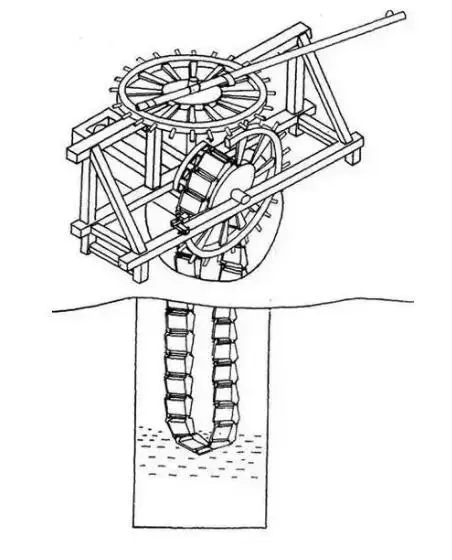
water-lifting well(ya shuijing)
A water-lifting well, also known as a suction pump well, is a tool used to bring groundwater to the surface. It is made of cast iron and has a cement block at the bottom. The wellhead serves as the water outlet, with a wider diameter at the back and a narrower diameter at the front. The tail end is connected to a lever handle, which is usually around 20 to 30 centimeters long. Through frequent use, the lever handle becomes brighter. Inside the well is a water-lifting membrane, which relies on the force between the membrane and the well to lift the groundwater.
The water-lifting well has a piston on top and a valve at the bottom. Both the piston and the valve are one-way valves, allowing air to move upward but not downward. When the piston moves upward, the valve opens, allowing the air from the pipe below to be drawn into the upper chamber. When the piston moves downward, the valve closes, and air escapes from the side of the piston. This process creates a vacuum in the pipe below, causing the water to be lifted up due to atmospheric pressure. However, if the seal is not good, air from outside may leak in when the piston moves upward, or the air in the upper chamber may leak into the pipe below when the piston moves downward. This makes it difficult to create a vacuum in the pipe. With the sealing effect of water and improved sealing after adding water, the well can quickly draw water. The purpose of lifting water is to ensure the sealing effect.
In areas where the water table is relatively high, water-lifting wells can usually draw water without the need for lifting. The only exception is when the groundwater has a high alkali content.
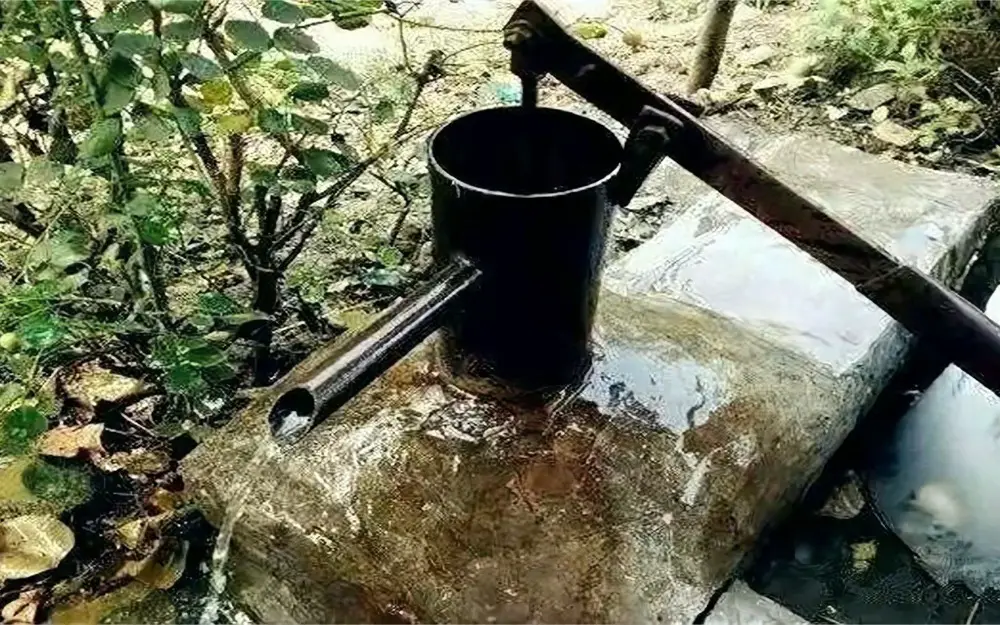
how to find water to drill a well?
Based on the distribution of underground water and the lithological structure of aquifers, various types of wells have been created.
In traditional Chinese practices, the commonly used well type is the cylindrical well. It has a diameter of 1 to 2 meters and a depth ranging from a few meters to 20 to 30 meters. During construction, people can directly enter the well shaft to excavate soil and rocks. This type of well is suitable for extracting shallow groundwater.
To extract deep groundwater, smaller diameter wells (ranging from a few centimeters to several tens of centimeters) with considerable depth (ranging from several tens of meters to several hundred meters) have been developed. Drilling these wells requires specialized drilling machinery and involves more complex processes. As early as 250 BC in what is now Sichuan Province, China, wells were extensively excavated to depths of tens to hundreds of meters in hard rocks.
When drilling reaches a confined aquifer containing brackish water, groundwater often flows out of the well naturally. Such wells are called artesian wells. The place name Ziyuan in Sichuan Province, China (now Zigong City), is derived from the presence of artesian wells. In modern times, countries worldwide primarily use drilled wells to extract groundwater, employing power drills and various types of pumps for water lifting.
Site selection: Before digging the well, a location with dense Artemisia vegetation is chosen. The well diggers rely solely on the presence of Artemisia on the surface as a guide, as they are unaware of the depth of the groundwater. However, the well depth is generally required to exceed thirty zhang (an ancient Chinese unit of length).
Excavation: In the past, the ancient tool used for well digging was called a “butterfly cone.” The cone’s head resembled a modern ice chisel, with two mud hoppers resembling butterfly wings at the top. While drilling the well, the cone head also brought the mud and sand into the mud hoppers. Once they were filled, the tool was pulled out of the ground for cleaning.
Construction of the well frame: The well frame is usually made of larch boards, but other types of timber can be used as well. The well frame is hexagonal, providing optimal structural support and strength. Carpenters cut the selected timber into thick boards and carve mortise holes and tenon heads on both ends of the boards, known as “gongmao and sun,” before fitting the boards together.
Lowering the well frame: Since most wells in plains are in soil layers and tend to be deep, which can easily collapse when soaked in water, the well frame is lowered simultaneously during well drilling. In places with shallow water tables, temporary wells are constructed using stones and bricks.
Soil excavation: Additionally, a few laborers are needed for manual labor. Under the direction of the well builder, the laborers fill the mud hoppers and then exert force to remove and clean the mud. Simultaneously, the carpenters progressively lower the well frame into the well, compacting it with a heavy hammer. This process continues until the well starts to yield water.
Water well in Chinese culture(what does a water well symbolize?)
- The Symbolism and Meaning of Wells: Wells symbolize nostalgia and are associated with a sense of longing for one’s homeland. The water from the well is believed to alleviate homesickness, and those who have left their hometown often use wells to express their longing for home and find solace in their souls. This perspective is unique to Chinese culture.
- Wells symbolize infinity. Regardless of changes or migrations in cities, wells remain unchanged and unaffected. The water in the well does not dry up or overflow, and people come and go to fetch water from the well. It symbolizes the source of life.
Water wells hold significant cultural and symbolic value in Chinese culture. They have been an integral part of Chinese communities for centuries and are associated with various cultural beliefs and practices. Here are some aspects of the water well’s significance in Chinese culture:
Symbol of Life: Water is a fundamental element of life, and wells represent the source of water, which sustains livelihoods and nourishes both people and the land. Wells are seen as a symbol of abundance, fertility, and prosperity.
Community Gathering Place: Wells traditionally served as gathering places for communities. People would gather at the well to fetch water, exchange information, socialize, and build connections. Wells became central meeting points where neighbors and villagers would interact, fostering a sense of unity and community spirit.
Nostalgia and Cultural Memory: Wells evoke a sense of nostalgia and cultural memory in Chinese culture. They are associated with childhood memories, traditional village life, and a connection to ancestral roots. The image of a well often triggers sentiments of longing for one’s hometown and represents a longing for simpler times and a sense of belonging.
Spiritual and Mythological Significance: In Chinese folklore and mythology, wells are sometimes regarded as portals or gateways to the spirit realm. They are believed to be connected to underground water deities or spirits, and offerings and rituals are conducted at wells to appease and honor these spirits.
Feng Shui and Well Placement: Feng Shui, the ancient Chinese practice of harmonizing energy in the environment, considers the placement of wells. Proper positioning of wells is believed to bring positive energy and fortune to a household or community. Wells are placed strategically to enhance the flow of Qi (energy) and promote harmony and prosperity.
Art and Literature: Wells have inspired numerous works of art, poetry, and literature in Chinese culture. They symbolize themes such as nostalgia, longing, resilience, and the cyclical nature of life. Poets and writers often used wells as metaphors to express profound emotions and philosophical insights.
Traditional Well Worship: In some regions of China, there are traditional rituals and customs associated with wells. Well-worship ceremonies may be performed during important festivals or to seek blessings for good fortune, health, and abundant harvests. These rituals reflect the deep-rooted cultural reverence for wells.
The cultural significance of water wells in Chinese society showcases their role as not just practical water sources but also as symbols of community, nostalgia, spirituality, and cultural heritage. They have left an indelible mark on Chinese art, literature, and collective consciousness, representing the vital connection between humans, water, and the land.
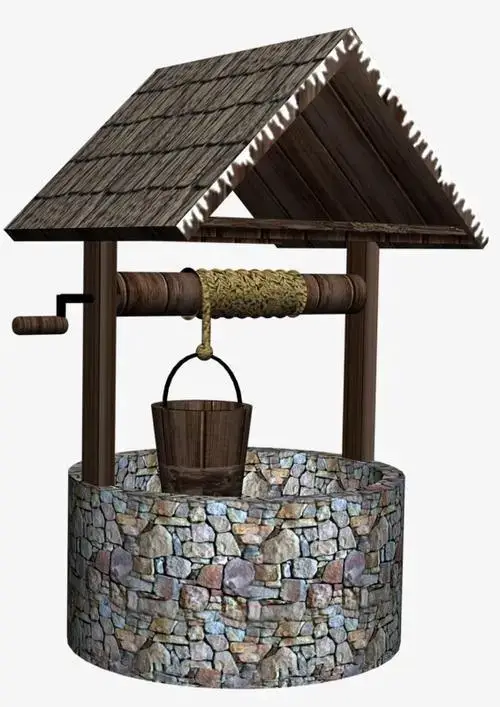
In Chinese, there are several place names that are related to wells. Here are some examples:
龙井 (Lóngjǐng): This is a famous place name in China and is associated with Longjing tea, a type of green tea. The name translates to “Dragon Well,” and it is believed to have originated from a legendary well in Hangzhou, Zhejiang Province.
井冈山 (Jǐnggāngshān): This is a mountain range located in Jiangxi Province, China. The name translates to “Well Ridge Mountain,” and it is named after a well found in the area that played a significant role in the Communist Party’s early revolutionary activities.
井陉 (Jǐngxíng): This is a county in Hebei Province, China. The name translates to “Well Pass,” and it is named after a well-known passageway in the area.
井研 (Jǐngyán): This is a county in Sichuan Province, China. The name translates to “Well Quarry,” and it is believed to have originated from the presence of abundant wells and stone quarries in the region.
井冈 (Jǐnggāng): This is a town in Jiangxi Province, China. The name translates to “Well Ridge,” and it is named after the nearby Jinggangshan mountain range.
井南 (Jǐngnán): This is a town in Shaanxi Province, China. The name translates to “South of the Well” and likely refers to its location in relation to a well in the area.
Longjing
Longjing Village is located southwest of the West Lake Scenic Area, surrounded by mountains on all sides, with a trend of higher elevation in the north and lower in the south. The village has a permanent population of about 800 people and owns nearly 800 acres of high mountain tea plantations. The natural barriers formed by Beigaofeng, Shizifeng, and Tianzhufeng in the northwest of the village block the invasion of northwest cold winds. To the south is Jiuxi, a deep and wide valley that leads directly to the Qiantang River. The geographical conditions of ventilation and air circulation provide unique advantages for the growth of Longjing tea. The Longjing tea produced here ranks first among “Lion, Dragon, Cloud, and Tiger.” It is said that during Emperor Qianlong’s visit to the southern region, he tasted West Lake Longjing tea at Hugong Temple at the foot of Shifeng Mountain in Longjing Village. He praised it and sealed the eighteen tea trees in front of the temple as “Imperial Tea.” It is now the most famous tea in China.
There is a legend: It is said that in ancient times, there was a spring in the village that continuously flowed with clear and fragrant water, as if it were water bestowed by a dragon. The villagers carved a dragon head from stone and placed it at the spring source, allowing the water to spout from the dragon’s mouth, never ceasing. Later, a Fengshui master passed by the spring, drank its water, and found it miraculous. He suggested that the villagers build a well to store water for drinking. Thus, the villagers built a well at this location and named it Longjing (Dragon Well).
The village had the spring and the dragon first, followed by the dragon and the well, and then the well and the village. The name Longjing Village evolved from this. At the Hexagonal Well in Shangcun of Longjing, there is an ancient stone tablet. The inscription on the tablet reads: “Qingjingji: The well is named after the dragon, named Longjing Village, nurturing excellence and divine spirits. Village rules strictly prohibit: Inner wells are specifically for obtaining clean and fragrant water for drinking and eating. Outer wells are designated for washing clothes, and it is forbidden to throw dirty materials such as plows, harrows, taros, and foul-smelling substances into the well, nor is it allowed to dig well stones. Those who violate these rules will be fined five jin of oil and incense, with no exceptions.” The tablet was erected on a lucky day in the forty-ninth year of the Qianlong era.
Longjing is located on the southern side of the village road, descending in steps. The ancient well has a hexagonal shape, with a low well mouth that can be reached by hand, touching the clear well water. Moss covers the surroundings of the well, and after the villagers started using tap water, the ancient well became a place for women in the village to do laundry. Looking down at the ancient well, there is a sense of ancient atmosphere emanating from it, evoking deep emotions.
In the hearts of the people in Longjing Village, the dragon is considered sacred. After the village was named Longjing, the villagers built a Dragon Temple in the southeast corner of the village and worshipped the dragon as a deity. Every year on the Duanwu Festival (Dragon Boat Festival) in early May of the lunar calendar, the villagers invite the Dragon God out of the temple to visit Longgongwan Field Pond Creek on the east side of the village. The scene is grand and magnificent. Year after year, the people of Longjing Village continue their worship and inheritance of the dragon, remaining unchanged.

Wangfujing
Wangfujing is a famous commercial area in Beijing, China, located in the Dongcheng District. It is one of the busiest shopping streets in Beijing. The origin of the name “Wangfujing” has multiple explanations, but two common interpretations are as follows:
One explanation is that Wangfujing derives its name from the imperial palace (wangfu) that existed in this area during the Ming Dynasty. The palace had magnificent courtyards and buildings that captivated people’s attention and admiration. Over time, this area gradually developed into a bustling commercial district, but it continued to be known as “Wangfujing.”
Another explanation is that Wangfujing is named after the sweet and clear well water that was found here. It is said that the Qing Dynasty emperors frequented this place to obtain water for drinking, which added a historical significance to the name “Wangfujing.”
Regardless of the specific origin, both explanations highlight the historical importance and significance of Wangfujing. Today, Wangfujing commercial street has become a renowned tourist attraction and shopping paradise in Beijing, attracting millions of domestic and international visitors every year.

Lock Dragon Well (Suo Longjing)
Suo Longjing, also known as Suo Jiao Jing, is a physical object mentioned in Chinese mythological stories, reflecting the people’s longstanding ideal of water control. It is an important phenomenon in Chinese culture.
The earliest mythological legend is about Emperor Yu locking the Jiao Dragon. Related cultural legends include the Suo Jiao Jing in Yuzhou, Shun Jing in Jinan City, Gui Shan Zhi Qi Jing in Huaiyin, and the Suo Long Pillar in Suolong Village, Wushan County, Chongqing. Additionally, there are legends of Suo Longjing (Suo Jiao Jing) in Beixinqiao and Tanzhe Temple in Beijing, as well as in other provinces.
It’s worth noting that in the stories of Chinese Suo Longjing, Zou Jiao, Xuanjian Bridge, and the Ruirong Temple in Japan, the term “dragon” refers to a Jiao Dragon or Jiao (similar to the Jiao Dragon in the Zou Jiao and Yingchuan Falling Dragon events). The narrow sense of the dragon, such as in the legend of the “Toppled Tree Mystery” at Moshan in Donghu, Wuhan, can transform and cannot be locked. In Chinese culture, there is actually a distinction between the Jiao and the dragon.
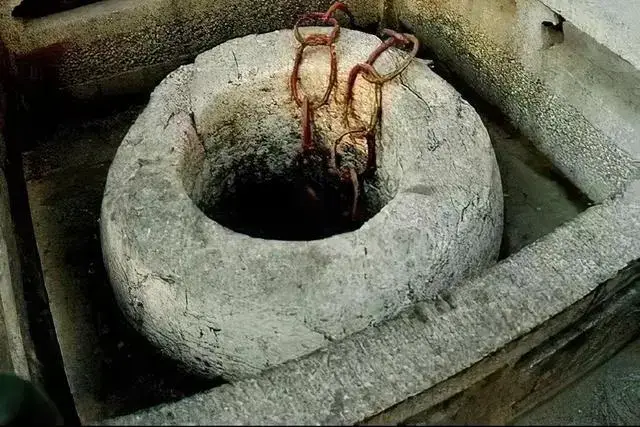
Jing Longwang
Jing Longwang, also known as the Well Dragon Prince, is a figure that is not well-explained in folklore. Sometimes, when there is a snake in a well, people believe it to be the manifestation of the Well Dragon Prince and quickly offer incense and pay their respects, refraining from harming it.
The Well Dragon Prince, also known as the Well God, was traditionally worshipped by the people during festive occasions. During the Lunar New Year, individuals would first erect a plaque near the well from which they draw water for daily use. Then, all families who rely on the water from that well would come to the well to perform rituals. The ritual involved offering food such as noodles or other items in a bowl, burning incense, and setting off three firecrackers. People would kowtow and pray for abundant water from the well and longevity for their families. The origins of the Well Dragon Prince are not clearly explained in folklore. Sometimes, when there is a snake in the well, people believe it to be the manifestation of the Well Dragon Prince and immediately offer incense and pay their respects, refraining from harming it.
According to Xu Fei’s “Responsibilities of Wells” during the Southern Song Dynasty, the Well Dragon Prince is personified as a child with an adorable image. He endures humiliation, bears heavy burdens, and faithfully fulfills his duties to ensure a water source during droughts. Despite his diligent efforts, his small authority often hinders his ability to satisfy everyone’s expectations. Sometimes, during severe droughts, people fail to appreciate his hardships and instead complain about his perceived lack of dedication. However, the Well Dragon Prince never disputes with people and tirelessly continues to knock on the gates of heaven, praying for divine intervention to relieve the drought and provide sweet water for the people to consume.
The worship of the Well Dragon Prince (Well God) has existed among officials and common people since ancient times. Liu Ruoyu, a Ming Dynasty scholar, recorded in “Ming Palace Officials” that to the east of the Wenhuadian Hall, there was a shrine called the “Shrine of Gods,” which housed a well. Every year, the deity of the well was worshipped there. “Qing Shih Gao” states, “In midwinter, there is a large well, and the Well God is worshipped in front of it.” Folk festivals and rituals involving wells are often conducted to seek auspiciousness for the year. In times of drought, the purpose of the well rituals is to protect the well from drying up. These rituals exhibit a strong practicality with deep reverence for nature.
Translation into English: The history of Shuijingfang can be traced back to Chengdu in the year 1408. At that time, a master winemaker surnamed Wang possessed the secret recipe for brewing top-quality Baijiu (Chinese white liquor) and came across an exceptionally pure and clean water well. With these elements, he successfully produced the finest liquor. Six hundred years later, in 1998, some construction workers accidentally discovered the original distillery site, which is documented as the oldest and most well-preserved independent liquor workshop to date. Shuijingfang has also been recognized by the Chinese National Cultural Heritage Administration as the “First Distillery of Chinese Baijiu.”
Translation into English: The history of Shuijingfang dates back to 1408 in Chengdu. At that time, a renowned master winemaker named Wang possessed the secret recipe for producing the finest Baijiu and discovered an exceptionally pure and clean water well. This eventually led to the creation of the highest-quality liquor. In 1998, 600 years later, some construction workers accidentally unearthed the original distillery site, which is documented as the oldest and most well-preserved independent liquor workshop. Shuijingfang is also recognized by the Chinese National Cultural Heritage Administration as the “First Distillery of Chinese Baijiu.”
gujing tribute wine
In the year 196 AD, Cao Cao presented his hometown’s “Jiuyun Chunjiu” to Emperor Xian of Han, Liu Xie, and documented the brewing method in his memorial, giving rise to the name “tribute wine” (gongjiu). Although the Jiuyun brewing method at that time only produced yellow wine, it has been passed down for thousands of years and eventually created a well-ordered lineage of famous wines known as “Gu Jing Gongjiu” (Gu Jing Tribute Wine).
Gu Jing is located in Jiandianji, 20 kilometers west of Boxian County, and has a history of over 1,400 years. It is said that the area is rich in saline-alkaline soil, and most of the water has a bitter taste, except for a single well with clear and delicious water known as Gu Jing. Legend has it that this well is the one into which General Dugu, who had fought fiercely against General Yuanshu during the Northern Wei period, threw his golden mace and long spear before his death. This is the well from which the present-day Gu Jing fine wine is brewed.
Gu Jing Tribute Wine is renowned for its unique color, aroma, and taste. The wine is clear and transparent, with a pure fragrance like orchids. It has a sweet and mellow taste upon consumption and leaves a lingering aftertaste. During the Southern and Northern Dynasties, Fan Zihu, a great general of the Northern Wei, defended Qiaocheng (present-day Anhui, Bozhou) with his troops. One day, Emperor Wu of the Liang Dynasty sent General Yuanshu to attack Qiaocheng. Seeing the fierce approach of the Liang army, Fan Zihu devised a plan and instructed his subordinates to hang a truce banner on the gate, intending to wait until the Liang army’s momentum waned before leading his troops to counterattack. Hearing the continuous shouting from the Liang army outside the city, a general named Dugu in Fan Zihu’s army could not contain his anger. He mounted his horse, wielding the Fangtianhuaji (a legendary weapon), and charged out of the city with a group of soldiers. However, being outnumbered, he was surrounded by the Liang army. Realizing that escape was impossible, General Dugu threw his Fangtianhuaji into a nearby well and then took his own life by drawing his sword. To commemorate General Dugu, a temple called Dugu General Temple was built in Jiandian, with more than 20 water wells dug around the temple. Due to the passage of time, only four wells remain today, among which one well stands out for its unique water flavor. The Jiandian area is a salt-alkaline land, and the taste of the water from most wells is bitter, except for this well, which has a sweet and clear taste, reminiscent of egg whites. This well is over ten meters deep, with a normal water level of three meters, and it can reach up to four meters during high water levels. This well never overflows or dries up throughout the year, with its water being clear and transparent and rich in minerals. The wine brewed by the ancients using this water is characterized by its rich aroma and sweet mellowness. Therefore, people call it the “famous well under the heavens.” Emperor Wu of the Liang Dynasty once posthumously honored General Yuanshu as the “Prince of Xianyang.” Due to a mispronunciation of “Xian” and “Jian,” this place became known as “Jian Jiadian” (present-day “Jiandianji”), and the fine wine produced here came to be called “Jianjiu” (Jian Wine). Jianjiu has always been regarded as a rare gem among wines. During the Wanli era of the Ming Dynasty, this wine became a tribute item, and this tradition continued until the Qing Dynasty, leading to the name “Gu Jing Gongjiu” (Gu Jing Tribute Wine).

shui jing fang wine
The history of Shuijingfang can be traced back to Chengdu in the year 1408. At that time, a master winemaker surnamed Wang possessed the secret recipe for brewing top-quality Baijiu (Chinese white liquor) and came across an exceptionally pure and clean water well. With these elements, he successfully produced the finest liquor. Six hundred years later, in 1998, some construction workers accidentally discovered the original distillery site, which is documented as the oldest and most well-preserved independent liquor workshop to date. Shuijingfang has also been recognized by the Chinese National Cultural Heritage Administration as the “First Distillery of Chinese Baijiu.”
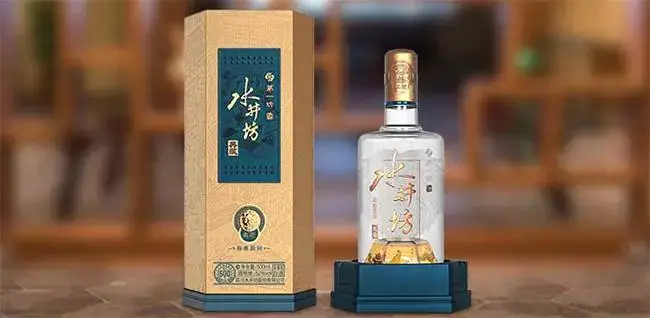
Customs about wells(Zhoushan City, Zhejiang Province)
carry Water well girl
On the evening of the 13th or 14th day of the lunar month, two unmarried girls who have living parents (at least one unmarried girl must go to invite, but because they are going to communicate with the goddess, it must be a mature and steady person; otherwise, the goddess will not be pleased) prepare offerings such as incense and candles and go to the edge of the well to make offerings. (The adults prepare a “flower sedan,” which is actually a rice-washing winnowing basket. They prepare a red sacrificial wooden tray, cover the winnowing basket on top, and insert a bamboo tube on one side to hold up the winnowing basket. A stick of incense is inserted next to the bamboo tube, and it becomes a flower sedan.)
They perform a prayer with kind words in front of the “flower sedan,” and then carry the “girl” back home. They place a table in front of the stove, place the “girl” on the table, and sprinkle flour on top. They offer incense, candles, and tea fruits on the stove.
The two girls with living parents carry the rice-washing winnowing basket, and it is crucial to pay attention to the method: Each person extends their index finger to hook the winnowing basket from both sides. They must also be mindful of the strength and not hold the winnowing basket too tightly to allow for the movement instructions from the well goddess. Then they can sincerely divine.
If the observer harbors doubts in their heart, they must not voice them; otherwise, it will not be effective. In this way, all the women and elders in the house will ask questions and receive good answers. Finally, the immortal maiden must be devoutly sent back to her original place.
water well Contemporary Importance:
Water wells continue to hold great importance in contemporary times for several reasons:
Access to Clean Water: Wells provide a direct source of clean and safe drinking water in areas where reliable municipal water supply systems are absent or unreliable. They are especially vital in rural and remote regions, ensuring access to clean water for communities, agriculture, and livestock.
Drought Resilience: Wells offer a reliable water supply during periods of drought when surface water sources may be depleted or unreliable. They help mitigate the impact of water scarcity and ensure water availability for essential needs.
Independence and Self-Sufficiency: Having a water well provides independence from external water sources and reduces reliance on water utility providers. Individuals and communities with wells have greater control over their water supply and can be more self-sufficient.
Agricultural and Irrigation Needs: Wells play a critical role in supporting agricultural activities by providing water for irrigation. They enable farmers to grow crops, increase agricultural productivity, and ensure food security.
Emergency Preparedness: Wells serve as an essential resource during emergencies and natural disasters when regular water supplies may be disrupted. They can provide a lifeline for affected communities, ensuring access to clean water for drinking, sanitation, and hygiene.
Environmental Sustainability: Wells can promote sustainable water management by tapping into underground aquifers and reducing reliance on surface water sources. Properly managed wells can help preserve surface water ecosystems and contribute to long-term water resource sustainability.
Economic Benefits: Well drilling and maintenance activities create employment opportunities in the water industry, supporting local economies. Additionally, reliable access to water enhances economic activities such as agriculture, livestock rearing, and small-scale businesses.
Groundwater Research and Monitoring: Wells serve as valuable sites for monitoring groundwater levels, quality, and hydrological studies. They provide critical data for assessing groundwater resources, understanding aquifer dynamics, and managing water supplies effectively.
In summary, water wells continue to hold contemporary importance by providing access to clean water, ensuring drought resilience, promoting independence and self-sufficiency, supporting agriculture, enhancing emergency preparedness, fostering environmental sustainability, offering economic benefits, and facilitating groundwater research and monitoring.
water well feng shui
In many rural areas in China, households rely on water wells for their daily water supply, as they may not have access to piped water. Even if the wells are no longer in use, they are rarely filled up. The location of each well varies, with some wells situated within the courtyard and others outside. The positioning of wells is influenced by feng shui considerations:
Is it good feng shui to have a well in front of the door?
In feng shui, it is generally considered unfavorable to have a water well directly in front of the house’s main entrance. Ideally, the area in front of the house should be flat to allow the flow of energy and promote a stable qi field within the home. If there is a water well in front of the main entrance, it is preferable to have a distance of at least 20 meters. If the distance is too close, it can affect the overall luck and fortune of the household. The worst feng shui scenario is a dried-up well, which can lead to health issues and decreased financial luck.
How to resolve the presence of a well in front of the door?
Cover the well: Whether the well is in use or not, it is advisable to cover it with a well cap. This helps to prevent accidents and restrict the flow of negative energy. If there is an uncovered well in front of the house, it can have a detrimental effect on the well-being and mental state of children.
Fill the well: If the well is no longer in use, it is best to fill it up to prevent the accumulation of negative energy. It is recommended to use yellow-colored new soil for filling and ensure that there are no empty spaces. This approach is considered auspicious and avoids violating any taboos.
Hang a Bagua mirror: If the household has strong positive energy, the presence of a water well may have minimal impact. However, if there are young children in the house, hanging a Bagua mirror on the main entrance can reflect the impure energy from the well outward.
Use red paper: The most common method is to affix red paper near the well’s opening, ensuring it is firmly attached. This practice helps to suppress any negative energy, preventing it from rising to the surface and affecting the feng shui of the home.
Other feng shui taboos related to wells
- It is best to avoid having trees near the well, as it is considered inauspicious. However, bamboo or similar plants do not pose any issues.
- The well should not be directly opposite the kitchen, as it creates a situation of opposing yin and yang energies.
- The shape of the well’s opening should ideally be round or square, as irregular or peculiar shapes can directly impact the occupants’ health.
- The well should not be too deep, and the opening should be above ground level. If feasible, installing a protective fence around the well can contain any negative energy present.
- If the well is used for household water supply, it should not be located near toilets or garbage disposal areas. Such proximity can affect the water quality and the occupants’ physical health.
If a well in front of the door has been abandoned and is no longer in use, it is essential to promptly fill it with new soil. Allowing it to turn into a dried-up well for an extended period can significantly diminish the household’s overall luck and fortune.
dream of well meaning
Here is the translation of the dream interpretations related to wells:
- If a person who is about to travel dreams of a well, it is advisable to postpone the trip and be cautious when encountering water.
- If a pregnant person dreams of a well, it signifies the birth of a girl. In winter, it suggests the birth of a boy. It is advised to avoid any soil-related activities.
- If someone in a romantic relationship dreams of a well, it indicates incompatibility and differences of opinion, suggesting that the marriage may not materialize.
- If a person born in the zodiac year dreams of a well, it suggests a relatively smooth period with some minor ups and downs, ultimately leading to fruitful results.
- If a person engaged in business dreams of a well, it represents overcoming obstacles and difficulties before achieving profits.
- If a married man dreams of a well, it indicates that his recent luck is good, and there may be visits from close friends.
- If a person with disabilities dreams of a well, it signifies a desire to be treated without discrimination and to be seen in a positive light by others.
- If a person in a romantic relationship dreams of a well, it suggests a poor love life with a high likelihood of conflicts arising from differing opinions.
- If a person seeking employment dreams of a well, it indicates an improvement in job prospects and the possibility of receiving recommendations from friends, leading to smooth progress.
- If a physically laborious worker dreams of a well, it signifies that the head is a vulnerable area, so caution is advised when going out.
- If one dreams of their own shadow reflected in a well, it implies a possible decline in work or academic performance. It is especially important to focus on work or studies during this period.
- If one dreams of throwing stones into a well, it suggests the possibility of meeting a desired partner. However, it also serves as a reminder to avoid meeting near the sea, river, or lake to prevent accidents.
Please note that dream interpretations are subjective and may vary based on cultural beliefs and personal experiences.
背井离乡beijinglixiang(leave one’s native place)
“beijinglixiang” is a Chinese idiom that originated from the play “Han Palace Autumn” by the Yuan dynasty playwright Ma Zhiyuan. It means to leave one’s hometown and go to a foreign place. The idiom uses the metaphor of a well to represent one’s hometown. It is commonly used as a predicate or attributive in sentences.
“If I, the Emperor, were to send you, Mei Xiang, away, you would leave your hometown, endure snow and frost. If he doesn’t long for the spring breeze in the painted hall, then I will bestow upon you the title of a queen.” (From Act III of “Han Palace Autumn” by Ma Zhiyuan)
This quote is a rebuke from Emperor Yuan of Han to his ministers when he bids farewell to Wang Zhaojun. Later on, people derived the idiom “beijinglixiang” from this passage.
井底之蛙jingdizhiwa(he frog at the bottom of the well)
“The frog at the bottom of the well” is a Chinese idiom that originated from the work “Zhuangzi – Autumn Floods” by the philosopher Zhuangzi during the mid-Warring States period. This idiom refers to people with shallow knowledge and limited perspectives, likening them to the frog living at the bottom of a well. Here’s the story:
There was a frog that lived at the bottom of a well for a long time. It believed that the well it lived in was the best place in the whole world. The water in the well was clear and tasty, and the mud at the bottom of the well was soft and comfortable. Whenever it lifted its head, it could see the blue sky and white clouds above the well’s opening. It felt incredibly content. Apart from occasionally jumping up to the well’s edge to bask in the sun, it hardly ventured outside.
One day, a sparrow flew down to the well’s edge and spotted the frog. Looking down, the sparrow said, “Frog, what are you doing in the well? Come out and play with me outside!” The frog replied disdainfully, “What’s there to do outside? This place is so comfortable.” The sparrow continued, “Do you know, Frog, on the other side of the mountains, there is a vast ocean that is much larger than your little well. Let’s go and explore it!” But the frog scoffed, “Ocean? I’m not going there. This well is the best place for me!” With that, the frog swam back to the bottom of the well and fell asleep, ignoring the sparrow. Seeing the frog’s disinterest, the sparrow flew away.
The next day, while the frog was still sleeping at the bottom of the well, it heard some rustling noises from above. It looked up and saw a turtle passing by the well. The frog immediately called out to the turtle, “Friend, it’s cool and comfortable down here in the well. Come down and swim with me!”
The turtle agreed, but its body was too large. As one leg went down, the other got stuck, and no matter how it struggled, it couldn’t get inside the well. Smiling, the turtle said to the frog, “I’ve never encountered this situation before. I live in the vast ocean beyond the mountains. It’s huge, and no matter how far I swim, I can never reach its edge. Regardless of the time or the amount of rain, the water in the ocean remains the same. That’s why I love the ocean so much.”
Hearing the turtle’s words and recalling what the sparrow had said the day before, the frog realized, “Could there really be a place larger than my well?”
坐井观天zuò jǐng guān tiān(Sitting in a well, observing the sky)
“坐井观天” (zuò jǐng guān tiān) is a Chinese idiom that originated from the poem “Original Way” by the Tang Dynasty poet Han Yu. Here’s the basic information about the idiom:
Chinese: 坐井观天
Pronunciation: zuò jǐng guān tiān
Literal translation: “Sitting in a well, observing the sky”
Explanation: It means having a narrow vision and limited knowledge. It is used to describe and satirize people with narrow perspectives or shallow knowledge.
Since the character “坐” (zuò) has multiple meanings, the phrase can also be interpreted as “sitting” or “seated.” The idiom is used metaphorically to emphasize the act of sitting at the bottom of a well and trying to observe the vast sky from that limited viewpoint.
落井下石luojingxiashi(Throwing stones into the well after someone falls in)
“落井下石” (luò jǐng xià shí) is a Chinese idiom that originated from the tomb inscription of Liu Zihou, written by the Tang Dynasty poet Han Yu. Here’s the information about the idiom:
Chinese: 落井下石
Pronunciation: luò jǐng xià shí
Literal translation: “Throwing stones into the well after someone falls in”
Explanation: It means that when someone is about to fall into a well, instead of extending a helping hand, they push the person down and even throw stones at them. It metaphorically refers to adding harm to someone who is already in a difficult situation.
井水不犯河水(well water does not violate river water)
This term can also be understood literally, as underground well water and surface river water are not connected and naturally do not violate each other.
In fact, the “well water” and “river water” here do not refer to literal water on the ground but rather to celestial bodies in the sky. “Well” originally referred to the Well mansion among the twenty-eight constellations, also known as the “Eastern Well,” which corresponds to the constellation Gemini in Western astronomy and is located near the Milky Way. The “river” refers to the Milky Way, and to the northeast and southeast of the “Eastern Well,” there are two prominent constellations called the “Northern River” and the “Southern River.” They were regarded by ancient people as the guardians of the Milky Way, and any changes in them were believed to bring calamity to the human world. The saying “井水不犯河水” (well water does not violate river water) originally referred to the harmonious coexistence of the three constellations, the Eastern Well, the Northern River, and the Southern River, without interference or disturbance, as observed by ancient people to predict fortune and misfortune based on celestial phenomena.
However, in modern times, “井水” (well water) and “河水” (river water) have been understood as water in wells and rivers, respectively. Well water belongs to groundwater, while river water belongs to surface water. Well water and river water are not connected and do not have the conditions to violate each other. As a result, well water rises in winter and recedes in summer, while river water rises in summer and recedes in winter due to seasonal changes. There is no factual violation between them as they interact with each other in a way where one advances while the other retreats based on the seasons.
Conclusion
The water well holds a significant place in China’s history and remains an essential component of its water management infrastructure. From ancient times to the present day, water wells have been crucial in providing access to clean water for drinking, irrigation, and industrial use. Despite the availability of modern water supply systems, many communities in rural areas still depend on wells. As China continues to address water challenges, the role of water wells will evolve alongside innovative technologies and sustainable practices to ensure a reliable and safe water supply for its people.